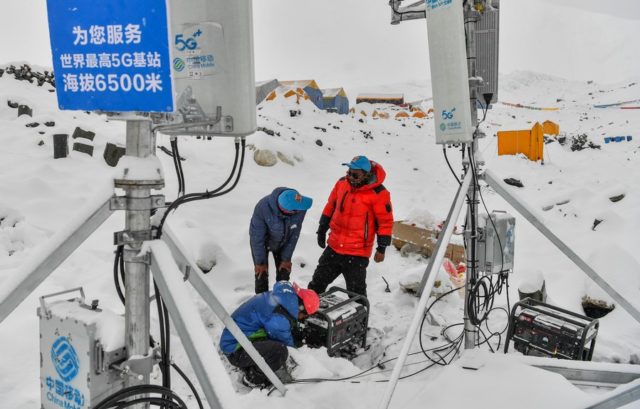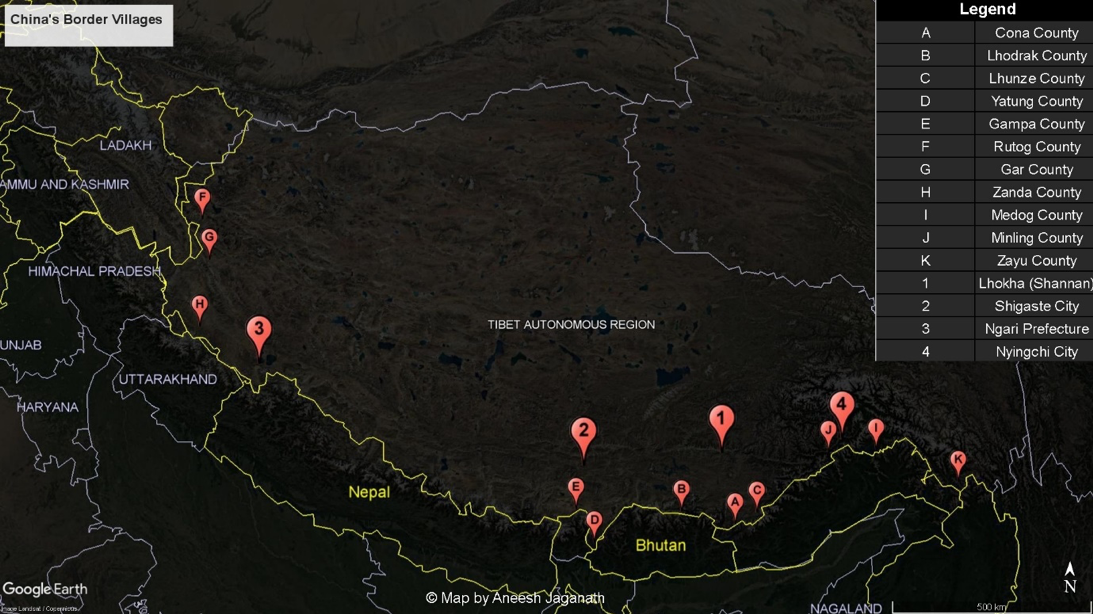
China’s Next Generation Infrastructure Development in Tibet: Implications for India
Publication: China Brief Volume: 22 Issue: 1
By:

Introduction
It has been 71 years since the People’s Republic of China (PRC) and the local government of Tibet signed a 17-point agreement on “the peaceful liberation of Tibet” (Central Tibetan Administration, May 23, 2019). Nevertheless, the region remains a major source of insecurity and vulnerability for the Chinese Communist Party (CCP). The PRC considers Tibet an integral part of China and since 1999, has invested heavily in the region’s dual-use infrastructure under its western development strategy (西部大开发, xibu da kaifa) (China Brief, November 19, 2021). Under General Secretary Xi Jinping, emphasis on infrastructure development in Tibet has continued. China has not only invested in conventional infrastructure development such as roads, railways and airports, but also in border defense villages, and next generation infrastructure including internet connectivity projects (for a discussion of the PRC’s construction of transportation infrastructure in Tibet, see part one of this series, China Brief, November 19, 2021) )
This article reviews the next generation infrastructure that China is building and developing in Tibet, which includes xiaogong villages on the borders with India, Nepal and Bhutan, a new all-weather oil pipeline, and power, and internet connectivity infrastructure across the restive Tibetan plateau. The subsequent section considers the implications of these developments for China’s unresolved border dispute with India.
Next Generation Infrastructure Development in Tibet
Since late 2016, Chinese central leadership has pursued a policy of developing “well-off villages in border areas” (边境地区小康村建设规划, bianjing diqu xiaokang cun jianshe guihua) in the Tibet Autonomous Region (TAR) as part of its rural revitalization program. The TAR government’s 2017 Work Report mentioned for the first time “the construction of well-off villages and simultaneous relocation of Tibetans in these villages” [1]. However, this process only accelerated after the 19th Party Congress in October 2017, when Xi called for “Chinese people with talent to work in remote poor areas, border areas with the ethnic minority population, as well as in communities and on the frontlines” (Xinhua, November 3, 2017).
In July 2017, the TAR government issued the “Plan for the Construction of Well-off Villages in the Border Areas of the Tibet Autonomous Region (2017-2020)” (Tibet.cn, May 11, 2019). The plan involves building 628 villages in the TAR’s 112 border towns across 21 border counties in Shigatse, Lhokha, Nyingchi and Ngari prefecture-level cities (56-China.com, December 18, 2020).

Map by Aneesh Jaganath, Researcher at The Takshashila Institution (see table 1 for the detailed data on China’s border villages)
Of these 628 administrative border villages, 427 are first-line villages and 201 are second-line villages. Of these 427 first-line villages, Shigatse city is building 354 villages along the borders with Bhutan, Nepal and the Indian state of Arunachal Pradesh [2]. Through this initiative, the PRC plans to move 62,000 border residents and 241,835 people into 62,160 households across 628 villages (Huanqiu, August 12, 2020). The Central government has allocated around RMB 30.1 billion (approximately $4.6 billion) for this initiative, which was expected to be completed by 2020 (56-China.com, December 18, 2020). The recent TAR government’s Autonomous Region Strong Frontier Work Conference noted that 94% of the project had been completed by December 2020 [3]. A recent People’s Daily article also highlighted that China had completed construction of 604 well-off border villages by mid-2021 (People’s Daily, August 13, 2021). All 628 planned border villages will likely be constructed before the 20th National Party Congress in fall 2022.
Table: China’s Border Villages [4]
| No | Prefecture-level City | County | Villages |
| 1 | Lhokha City | Cona County | Quna Village, Yama Rong Village, Khatak Village |
| Lhodrak County | Lhakhang Township, Gongzu Village, Sangyul Village, Lagyab Township | ||
| Lhunze County | Zhongna Village, Yumai Border Well-off Village, Dakri Township, Douyu Lopa Township, Sanlin Township, Jieluobu (Gyalaphug) Village | ||
| 2 | Shigaste City | Yatung (Dromo) County | Guru Village, Pangda Village |
| Gampa County | Jiru Village | ||
| 3 | Ngari Prefecture | Rutog County | Jagan Village – Risom Township |
| Gar County | Dianjiao village (Demchok) – Zhaxigang township | ||
| Zanda County | Chusong Village – Chulu Songjie Township | ||
| 4 | Nyingchi City | Medog County | Dhamo Village – Lopa Ethnic Township, Guthang Township |
| Minling (Mainling) County | Dekyi New Village – Linlong Township, Bangzhong Village, Qionglin Village | ||
| Zayu County | Zhala Village – Zhuwagen Town, Shama Village – Xiayu Township, Kyoto Village, Jingdu Village – Zayu township, |
Note: The above table is not a comprehensive list of all 628 villages but broadly representative of development on the India-China, China-Bhutan and China-Nepal borders.
Furthermore, China is also trying to connect these border villages and the entire Tibetan plateau to internet and power facilities. The Lanzhou-Xining-Lhasa optical cable communication line (兰州-西宁-拉萨”光缆通信专线, Lanzhou-Xining-Lasa guanglan tongxin zhuanxian) connects Tibet with the rest of the country (Sohu, July 24, 2021). By the end of 2019, Tibet had complete access to the optical fiber network, and even border defense villages reportedly had a 4G access rate of around 98% (Tibet.cn, January 24, 2019). Some Tibetan towns even have 5G network access, and under the current 14th Five-Year Plan (FYP), China aims to increase 5G access across the region (Gov.cn, March 13, 2021). Similarly, by December 2020, China had connected all 66 counties and eight districts in the TAR to the central power grid (People’s Daily, February 26, 2021). The 2021 TAR Work Report calls for electrification of all villages along the borders with India, Bhutan and Nepal [5]. Moreover, the PRC is also reconstructing the “Snow Mountain Oil Dragon” (雪山油龙, xueshan you long) pipeline, as the old pipeline is scheduled to be decommissioned due to corrosion of pipes (Guangming Daily, July 21, 2021). The newer line will be 1,076 km long, over 150 mm larger in diameter and will run parallel to the existing line from Golmund to Lhasa [6]. Furthermore, the 13th FYP stipulated that China would also increase the number of oil depots in Tibet to ten. It is unclear if this target was met during the plan period (China News Network, January 8, 2016).
Implications for the Border Dispute with India
Article VII of the Political Parameters and Guiding Principles for the Settlement of the Boundary Question, a pact that the Indian and Chinese governments signed in April 2005, stipulates that “the two sides shall safeguard due interests of their settled populations in the border areas” [7]. Furthermore, Article 10 from Chapter 1 of China’s recently passed border law charges the state with adopting effective measures to strengthen border defense construction, support economic and social development along the border, and enhance public services and infrastructure construction to improve living conditions of residents in these areas (for further details see NPC Observer, October 23, 2021). Although village construction is part of China’s domestic agenda of “developing the border regions [and] enriching the local people” (兴边富民, xìng biān fùmín) highlighted in 1999, it should also be interpreted as efforts by China to legitimize a land version of the kind of “salami-slicing” tactics, which the PRC has employed in the South China Sea [8]. Raising permanent infrastructure like electric grids and providing internet connectivity to these villages supplements these efforts by making these areas more conducive to permanent settlement. In doing so, China aims to reaffirm its claims to disputed territory along the India-China border. Upon completion, these villages would also act as border watch posts for the PLA and help the PRC limit cross-border Tibetan migration.
Moreover, improved internet and power connectivity help the PLA and China’s border defense units sustain a presence in the region for longer durations. For instance, during the 2020 India-China stand-offs at five disputed locations in eastern Ladakh, Chinese troops were reportedly laying optical fiber cables near the Himalayan border. Such lines are militarily important as they provide forward-deployed troops with a secure line of communication with the rear and inland bases.
Similarly, the oil pipeline, one of the three major arteries (along with the Golmund-Lhasa oil pipeline and Qinghai-Tibet highway), which connects Tibet to China proper coupled with improved logistics and oil depot construction in the TAR, suggest that China is planning not only for rapid mobilization of forces to the border, but also for sustained deployments along the border areas [9].
Conclusion
China’s extensive conventional and next generation infrastructure development in the TAR and areas close to its southern border with India enhances its operational capability in the region and also boosts the local economy. Such extensive conventional and new-age infrastructure development and ongoing military reforms including an intensified Military-Civil Fusion (MCF) national strategy could help China deploy forces to forward positions for extended periods and mobilize counter-attack units relatively quickly from inland if required. Put simply, such developments could provide the PRC with an operational advantage along the border with India in the future.
Suyash Desai is an Associate Fellow, China Studies Programme, The Takshashila Institution, India. He studies China’s defense and foreign policies and writes a weekly newsletter on the Chinese armed forces called the PLA Insight. This article is inspired by his research project on China’s civilian and military developments in Tibet and its implications on India.
Notes
[1] See “2017 Tibet Autonomous Region Government Work Report” [2017 年西藏自治区政府工作报告], General Office of the People’s Government of Tibet Autonomous Region [西藏自治区人民政府办公厅], February 13, 2017. https://www.xizang.gov.cn/zwgk/xxfb/zfgzbg/201902/t20190223_62067.html
[2] For more on the PRC’s border construction, see “The Tibet Insight News,” Centre for China Analysis and Strategy, April 1-15, 2019. https://www.ccasindia.org/Tibet-Insight-News-Report-1-15-Apr-2019.pdf
[3] For more, see “Tibet Insight,” Centre for China Analysis and Strategy, October-December 2020. https://www.ccasindia.org/Tibet-Insight-News-Report-Oct-Dec-2020.pdf
[4] Compiled based on multiple sources from the Chinese internet like cppc.gov.in, Tibet.cn, Tibet Daily, TAR Government Work Reports, Sohu, Huanqiu; Jayadeva Ranade, “China’s Xiaogong (well-off) Border Defence Villages in the Tibet Autonomous Region, Vivekananda International Foundation, September 24, 2019. https://www.vifindia.org/article/2019/september/24/china-s-xiaokang-border-defence-villages-in-the-tibet-autonomous-region
[5] See “2021 Tibet Autonomous Region Government Work Report” [2020 年西藏自治区政府工作报告], General Office of the People’s Government of Tibet Autonomous Region [西藏自治区人民政府办公厅], March 24, 2021. https://www.xizang.gov.cn/zwgk/xxfb/zfgzbg/202103/t20210324_197174.html
[6] For details on the pipeline, read Wenbing Yu, Fenglei Han, Weibo Liu and Stuart Arthur Harris, “Geohazard and Thermal Regime Analysis of Oil Pipeline along the Qinghai-Tibet Plateau Engineering Corridor,” The Journal of the International Society for the Prevention and Migration of Natural Hazards 83, no 1 (2016): 193-209.
[7] See “Agreement between the Government of the Republic of India and the Government of the People’s Republic of China on the Political Parameters and Guiding Principles for the Settlement of the India-China Boundary Question,” Ministry of External Affairs, Government of India, April 11, 2005. https://mea.gov.in/bilateral-documents.htm?dtl/6534/Agreement+between+the+Government+of+the+Republic+of+India+and+the+Government+of+the+Peoples+Republic+of+China+on+the+Political+Parameters+and+Guiding+Principles+for+the+Settlement+of+the+IndiaChina+Boundary+Question
[8] See Shuxian Luo, “China Land Border Law: A Preliminary Assessment,” Brookings Blog, November 4, 2021. https://www.brookings.edu/blog/order-from-chaos/2021/11/04/chinas-land-border-law-a-preliminary-assessment/
[9] See Rajeshwari Pillai Rajagopalan and Pulkit Mohan, “PLA Joint Exercises in Tibet: Implications for India,” ORF Occasional Paper, February 26, 2020. https://www.orfonline.org/research/pla-joint-exercises-in-tibet-implications-for-india-61735/




